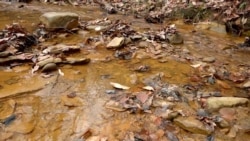The rusty orange streambed is a giveaway.
Paul Ziemkiewicz pulls off a winding country road at a stream about 45 kilometers east of Morgantown, West Virginia. The water is about as acidic as vinegar, he says. It's "100% fatal" to aquatic life.
"I doubt that even deer want to drink the water," he added. "it's useless."
This pollution, known as acid mine drainage, contaminates roughly 4,000 kilometers (2,500 miles) of West Virginia waterways. It's a legacy of more than a century of coal mining in the region.
Ziemkiewicz grew up in Appalachia, outside Pittsburgh, where, he said, "acid mine drainage was just way of life. Streams tended to be orange."
For the last 30 years, he has been working to clean up Appalachia's acidified waterways. Ziemkiewicz directs the West Virginia University Water Research Institute.
Now, he's found an unexpected silver lining in these polluted streams.
Or, perhaps more accurately, a neodymium lining.
Something in the water
Ziemkiewicz discovered minerals called rare earth metals are dissolved in the acidic water. These elements make some key modern tech work.
Neodymium, for example, is used in powerful magnets in wind turbines and electric vehicles. It makes the tiny magnets in cell phone speakers possible.
"If you were using a conventional iron magnet in your cell phone, your cell phone would be like a brick," Ziemkiewicz said. With rare earths, he added, "you can miniaturize things."
They also have critical military uses, from night vision gear to high-performance aircraft.
The F-35 Joint Strike Fighter is built with scandium alloys, for example. "It makes aluminum much stronger," Ziemkiewicz noted, "so you can make the wings thinner the body lighter."
But the United States has no domestic supplier of purified rare earth elements. About four-fifths come from China.
That's raised concerns that economic and national security could be threatened if China were to tighten supplies, as the country did in 2011. Beijing has signaled it could restrict exports in response to the Trump administration's tariffs on hundreds of billions of dollars of Chinese goods. So far, though, the rare earths have kept flowing.
Not so rare
Only one mine in the United States produces rare earths. It's actually not because they're rare, however, despite the name. It's because they typically are found in very low concentrations, mixed in with other minerals. Mining and purifying them is environmentally destructive, energy intensive and generally not profitable enough for most companies to invest in producing them.
They dissolve in acid, though, which is why Ziemkiewicz found them in acid mine drainage.
"It's basically letting nature do for free what you would have to do with a great deal of time effort and money," he said.
Ziemkiewicz is one of a handful of researchers looking into some of the coal industry's more unpleasant by-products as potential sources, with funding from the U.S. Department of Energy.
For example, when coal burns, rare earths are left behind in the ash.
"It's already concentrated," said University of Kentucky geologist Jim Hower. "The mining has been done. You've just got to get in there and recover it."
The waste left over from processing coal between mining and burning might also prove a valuable source. The region's long history of mining means there's plenty of it.
"We've had over 100 years of waste generated that's sitting on the surface," said University of Kentucky mining engineer Rick Honaker. That could provide "many years of supply" of rare earths.
However, the United States still lacks a facility to refine the minerals into pure metals. Even the rare earths mined in the United States are shipped to China to process.
Treasure from trash
The Department of Energy sees boosting domestic supplies as a first step. Ziemkiewicz received a $5 million DOE grant to scale up his lab's rare earth extraction system at a new acid mine drainage treatment plant to be built about 100 kilometers southeast of Morgantown.
He estimates that acid mine drainage across northern Appalachia could produce more than 2,000 tons of these critical minerals, out of the roughly 10,000 tons the United States uses each year.
And the money provides an incentive to clean up more waterways.
"You can't sell the water, but you can certainly sell the rare earth product," he said. "And if you can use that to pay for lime, pay for the people who operate the plants and improve your infrastructure and treat more streams, then this is how you have to go."






